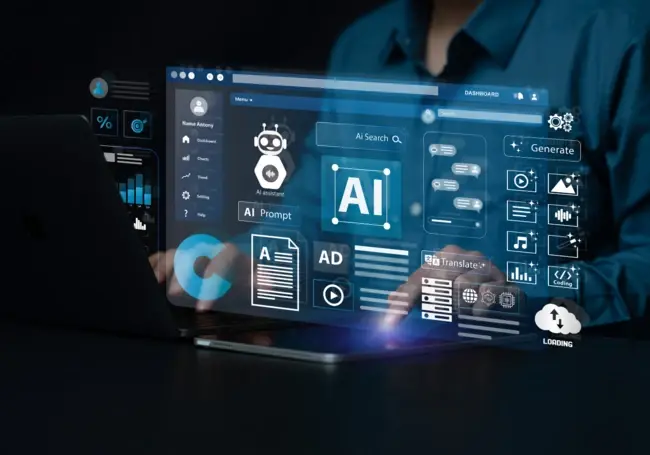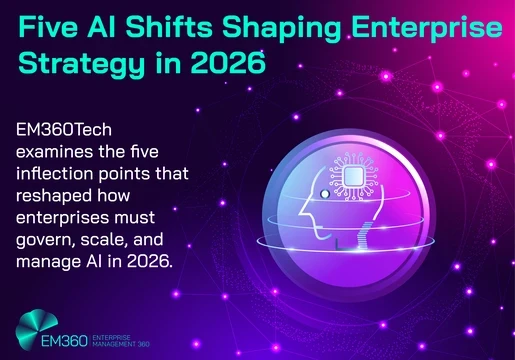As artificial intelligence (AI) evolves, so does the need for faster, more efficient, and scalable AI systems, especially in the enterprise space. Many traditional AI models and intensive learning approaches require massive computing power and are expensive to run. This makes it challenging for businesses to scale AI across operations without significant infrastructure investment.
At its core, AI enables machines to perform tasks that typically require human intelligence, such as learning from data, recognising patterns, understanding language, and making decisions. In this day and age, AI powers everything from customer service chatbots to predictive analytics and automated supply chains.

AI Overview
The AI market is growing at an extraordinary pace. Enterprise adoption has increased by more than 270 per cent in just four years, and the global AI software market is projected to reach $126 billion by 2025. AI is expected to drive 95 per cent of customer interactions by that time, making it a business-critical tool across industries.
The image below shows a basic example of how AI works. AI systems try to act like human intelligence by analysing data, spotting patterns, and understanding language. A big part of how AI works is matching information and making sense of it, similar to how our brains process knowledge. The goal is to copy human abilities like learning and understanding, but without needing constant human input.
However, the current pace of innovation demands more than what traditional architectures can offer. To meet growing performance and sustainability needs, a new generation of AI architectures is emerging.
These include innovations like low-power AI chips, capsule networks, hyperdimensional computing, and neuro-symbolic AI designed to make AI faster, smarter, more cost-effective, and easier to deploy at scale.
Let's break down the new AI architectures you should have on your radar, why they matter, how they’re different, and what they could mean for the future of enterprise AI strategy.
Why New AI Architectures Matter Now
As AI becomes more central to business operations, the pressure is on to make systems faster, more efficient, and easier to scale. Traditional AI models are powerful, but they often come with high costs and energy demands. New AI architectures are emerging to solve these challenges, making AI more practical, sustainable, and enterprise-ready than ever before.
So why does it matter?
1. Legacy AI can’t scale to today’s business demands
Most older AI systems were designed for narrow, low-volume use cases. The enterprise landscape is very different compared to a decade ago. This means AI must now process a large amount of volumes of text, images, video, and code, often in real time and across global operations. New architectures like Mixture-of-Experts models intelligently allocate resources, making them far more cost-efficient at scale. For example, Databricks' DBRX is outperforming older open-source models while reducing compute requirements, translating to real infrastructure cost savings and performance gains. As AI workloads grow, this kind of efficiency will be a competitive differentiator.
2. AI is no longer just a tool
We are seeing a shift from stand alone AI models to full AI systems: integrated frameworks combining memory, search, automation, reasoning, and business logic. This modular approach allows for greater control, customisation, and domain expertise, which is critical in sectors like finance, manufacturing, and healthcare. According to TechRadar, smaller, smarter systems, especially those paired with knowledge graphs, are now outperforming large models in real business settings. For execs, this means better results without expensive cloud bills.
3. Privacy, governance, and control are non-negotiable
Enterprise AI cannot be a black box. Boards and regulators are demanding transparency, explainability, and data sovereignty. In 2025, open-source models like Mistral and LLaMA are becoming the default for companies that need to customise and govern AI in-house without sending sensitive data to a third party. According to Andreessen Horowitz, enterprises are moving toward “stack ownership”, designing architectures they can trust, audit, and control. This move isn’t just a technical trend; it’s a strategic and legal necessity.
In 2025, tech giants are spending more than ever. Google is reportedly investing $85 billion in AI infrastructure, Amazon $100 billion, and Meta up to $72 billion. Even with billions being invested in AI, many businesses are still hesitant to fully trust the technology especially when it comes to safety, accuracy, and control.
Capgemini reports that while the value of autonomous AI is potentially clear $450 billion in enterprise gains, only two per cent of companies have fully deployed it. The blocker? Confidence in the system’s safety, reliability, and governance (ITPro). This is why modern architectures prioritise alignment, traceability, and compliance-by-design.
4. Agentic AI is accelerating and reshaping the stack
The fast-changing landscape of smart data platforms is transforming how enterprises manage and make use of their data, shifting from static systems to intelligent, agent-driven platforms that can act, adapt, and automate in real time. As Jay Mishra, CTO of Astera, recently explained on the Tech Transformed podcast episode titled “Why an Agentic Data Management Platform is the Next Generation Data Stack”
“So I think Gartner this year said that out of every four companies trying to implement some form of AI, one will be using an agentic solution, and by 2027, that number is going to double. Near-human reasoning is just one API call away. That, I think, is the key difference.”
With that said, this shift toward agentic AI systems that don’t just generate but decide and act is reshaping enterprise architecture. The growing use of vector databases, cognitive blocks, and semantic retrieval methods is no longer experimental. As Mishra notes, these capabilities are “table stakes” for organisations moving toward autonomous processes. These adoption patterns are de-risked by cloud maturity and tooling; the enterprise is no longer just exploring AI; it’s operationalising it.
5. AI must work anywhere
From smart factories to autonomous vehicles, AI increasingly needs to operate at the edge where connectivity is limited and latency is critical. New models like Mamba are designed for these environments, offering lightweight, fast processing without sacrificing accuracy. For companies investing in IoT, automation, or real-time analytics, this shift is important. It allows AI to move closer to the data and the decision without heavy cloud dependencies.
AI Architectures Shaping Enterprise Strategy
As enterprise AI adoption expands, the underlying architectures are evolving to meet new demands for scalability, efficiency, safety, and adaptability.
Here’s a closer look at ten architectural approaches gaining traction, each offering distinct advantages for real-world business applications.
1. Mixture of Experts (MoE)
Mixture of Experts (MoE) is a type of AI model that uses different parts of the network for different tasks. Instead of running every input through the whole model, MoE uses a gating system to choose only the most relevant parts, called experts, for each job. This makes it faster, cheaper, and more efficient to run.
The idea first came about in the 1990s by Robert Jacobs and Geoffrey Hinton, but it became more practical when Google introduced the Switch Transformer in 2021. Since then, MoE has become a popular way to build large AI models without using massive computing power every time. This means only a few experts are activated per task, meaning lower latency, less energy use, and greater throughput, all critical for enterprise deployment.
More recently, Databricks’ DBRX has shown how this can be done with open-source tools, giving businesses more flexibility and control. For enterprises, MoE means you can get the benefits of advanced AI, like better performance and faster response times, without the high costs or infrastructure demands of traditional models. In short, MoE makes AI smarter about how it uses its power. It enables large, powerful models to run more efficiently, making it a key architecture to watch as AI becomes more embedded in enterprise systems.
2. Retrieval-Augmented Generation (RAG)
One of the biggest limitations of traditional large language models (LLMs) is that they rely entirely on static training data. Once trained, they can't access new information unless they're retrained, an expensive, time-consuming process that still risks outdated or irrelevant responses. This is where Retrieval-Augmented Generation (RAG) comes in.
RAG is a next-gen AI architecture that connects LLMs to external, authoritative data sources in real time. Before generating a response, the model first retrieves relevant content from a knowledge base such as enterprise documents, research papers, or even live websites. It then uses that information, along with its internal training, to generate a far more accurate and context-aware answer.
The result is more accurate, explainable, and up-to-date outputs, without the high cost of retraining the entire model. For enterprises, this means they can build smarter chatbots, assistants, and knowledge tools that reflect their latest policies, products, and customer data.
RAG also increases user trust through transparency; responses can include source citations, helping teams verify the information behind the AI’s output. Developers, in turn, gain greater control over how the model behaves, what it references, and how it adapts over time. In short, RAG shifts AI systems from guessing based on past data to responding based on current knowledge. As AI adoption grows in sectors like finance, legal, healthcare, and government, architectures like RAG are becoming important not just for performance, but for trust and compliance too.
3. Multimodal Foundation Models
Multimodal foundation models are redefining how AI systems interact with the world, processing and understanding text, images, audio, and video within a single architecture. Unlike earlier models that focused solely on language, today’s systems like ChatGPT-4o, Gemini 1.5, and Claude 3 can respond to voice, describe images, summarise documents, and interpret video content all at once. This flexibility is particularly useful in enterprise settings such as healthcare, field service, and content moderation, where diverse inputs are common.
These models are built on two main components: large language models (LLMs) for text generation and understanding, and diffusion models, which create or refine media like images, speech, and video. By combining these technologies, multimodal systems are moving closer to human-like reasoning by seeing, hearing, and responding in full context.
| Input Type | Example Capabilities |
|---|---|
| Text | Understand and generate written content such as emails, essays, and reports. |
| Images | Recognise objects, edit visuals, or generate original artwork. |
| Audio | Transcribe speech, compose music, detect sentiment or emotion. |
| Video | Summarise scenes, identify actions, and extract insights from motion or visuals. |
The global multimodal AI market was valued at $1.73 billion in 2024 and is projected to grow to $10.89 billion by 2030, with a CAGR of 36.8 per cent. This growth is being driven by demand for AI that can make more accurate predictions and deliver real-time, context-rich responses across sectors like healthcare, customer support, field service and content moderation.
For enterprises, this means smarter, more adaptive AI tools that improve productivity, decision-making, and customer interaction, all without switching between systems. As this architecture grows, it’s expected to become a foundational layer in the next wave of enterprise AI, driving richer, more adaptive tools across industries.
4. Agentic AI architectures
One of the most promising new AI architectures is agentic AI, systems that go beyond simple prompts to autonomously plan, act, and complete multi-step tasks. Unlike traditional models that respond to isolated inputs, agentic architectures enable AI to operate more like a digital collaborator, coordinating actions toward a defined outcome. Open frameworks like AutoGPT and BabyAGI exemplify this shift. According to Gartner, by 2027, one in two companies exploring AI will use some form of agentic framework.
At the heart of this architecture is the ability for AI agents to exhibit intentionality, planning, memory, and even self-reflection, mirroring core aspects of human decision-making. As Jay Mishra, CTO at Astera, shared in a recent Tech Transformed podcast:
“Near-human reasoning is just one API call away”.
Agentic AI is already being tested in areas like workflow automation, data pipeline orchestration, and task-driven enterprise copilots. These systems use tool calling to retrieve real-time information, optimise workflows, and adapt to user preferences, all without constant human oversight. While still in development, agent-based systems are quickly becoming a foundational pillar of modern enterprise AI, offering the potential for meaningful productivity gains and more personalised automation at scale.
Watch the full episode here:
5. Edge AI and the rise of low-power intelligence
The convergence of Artificial Intelligence (AI) and the Internet of Things (IoT) has paved the way for Edge AI, an architecture where intelligent processing happens directly on devices at the edge of the network. Unlike traditional cloud-based models, Edge AI reduces reliance on constant connectivity, enabling real-time decision-making, lower latency, enhanced privacy, and greater resilience in mission-critical environments.
This shift is being driven by the explosive growth of edge devices, IoT sensors, wearables, smart appliances, and embedded systems. Yet, deploying AI on such devices introduces a unique challenge: they are often resource-constrained, with limited power, processing capacity, and memory.
Previous AI architectures were too power-hungry for this environment. But advances in low-power AI, including neurosynaptic-inspired models and efficient hardware, are changing that. These innovations allow AI workloads to run on microcontrollers and sensor nodes without draining battery life—making it possible to bring intelligence to even the smallest devices.
As edge use cases grow across sectors like manufacturing, healthcare, smart homes, and logistics, low-power AI has become a pillar of scalable, sustainable innovation. This basically means that low-power AI architectures enable real-time processing on devices with limited energy and computational resources, such as sensors and wearables. This capability allows enterprises to deploy AI in remote or constrained environments without relying on constant cloud connectivity, improving responsiveness and privacy. It's especially useful in remote or hybrid work settings.
AI Architectures Transforming Enterprise Tech
Understanding and adopting the latest AI architectures is important for enterprises aiming to stay competitive and innovative. From multimodal foundation models that integrate text, images, audio, and video, to agentic AI systems capable of autonomous multi-step actions, and low-power Edge AI enabling real-time intelligence on resource-constrained devices, these architectures are shaping the future of scalable, efficient, and adaptable AI.
For CIOs and CTOs navigating AI adoption, understanding these architectural approaches is more than a backend decision; it’s about aligning technology capabilities with business goals. If you are looking to build scalable assistants, automate operations, or run AI at the edge, choosing the right architecture now will determine flexibility, cost, and performance in the long term.
Enterprises that stay ahead of these AI developments will leverage the technology not just as a tool, but as a strategic advantage, transforming operations, enabling smarter decision-making, and unlocking new value across the organisation. As industry leaders compete to dominate this space, the opportunities for innovation and growth continue to expand rapidly.







Comments ( 0 )